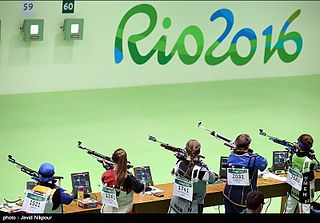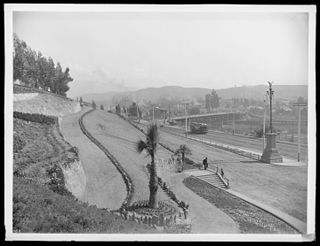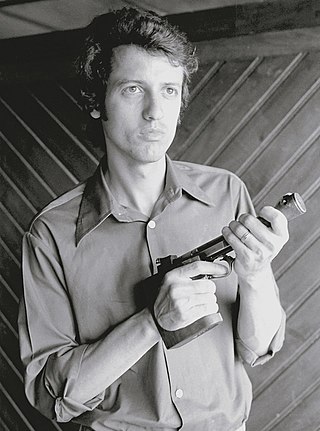
The International Shooting Sport Federation recognizes several shooting events, some of which have Olympic status. They are divided into four disciplines: rifle, pistol, shotgun and running target.

The men's ISSF 25 meter rapid fire pistol competition at the 2004 Summer Olympics was held on 21 August at the Markopoulo Olympic Shooting Centre near Athens, Greece. This was the last Olympic competition before the major rule changes that took place on 1 January 2005, and which lowered the results of the event. There were 17 competitors from 14 nations.

The men's individual competition with revolver and pistol, distance 50 metres was a shooting sports event held as part of the shooting at the 1912 Summer Olympics programme. It was the fourth appearance of the event, which was the only one to have been featured at every edition of the Games to that point. The competition was held on Monday, 1 July 1912. Fifty-four sport shooters from twelve nations competed. Nations were limited to 12 shooters each. The event was won by Alfred Lane of the United States, completing a double for him with the rapid fire pistol event. It was the United States' second victory in the event. Another American, Peter Dolfen, finished second. Charles Stewart of Great Britain took the bronze medal, the nation's first in the free pistol.

The men's ISSF 25 meter rapid fire pistol was a shooting sports event held as part of the Shooting at the 1932 Summer Olympics programme. It was the sixth appearance of the event. The competition was held on August 12, 1932. 18 shooters from 7 nations competed. Nations were limited to three shooters each. The event was won by Renzo Morigi of Italy, with Heinrich Hax of Germany taking silver and another Italian, Domenico Matteucci, earning bronze. They were the first medals in the event for both nations.

The men's ISSF 25 meter rapid fire pistol was a shooting sports event held as part of the Shooting at the 1924 Summer Olympics programme. It was the fifth appearance of the event. The competition was held on 28 June 1924 at the shooting ranges at Versailles. 55 shooters from 17 nations competed. Nations were limited to four shooters each. Henry Bailey won the United States' second consecutive championship in the event. Sweden also earned the same medal as in 1912, with Vilhelm Carlberg's silver. Lennart Hannelius took bronze in Finland's debut in the event.

The men's ISSF 25 meter rapid fire pistol competition at the 2000 Summer Olympics was held on 20 and 21 September. There were 20 competitors from 17 nations. Nations had been limited to two shooters each since the 1952 Games. The event was won by Sergei Alifirenko of Russia, the nation's first medal independent of the Soviet Union. Michel Ansermet's silver was Switzerland's first medal in the event since 1920; Iulian Raicea's bronze was Romania's first since 1984.

The men's ISSF 25 meter rapid fire pistol was one of the fifteen shooting events at the 1996 Summer Olympics. Ralf Schumann defended his title from Barcelona, setting two new Olympic records. Schumann was the third man to successfully defend an Olympic title in the rapid fire pistol, and the first to win three or more medals in the event; he would finish with three golds and five total medals. Emil Milev of Bulgaria (silver) and Vladimir Vokhmyanin of Kazakhstan (bronze) each won their nation's first medal in the event, though Vokhmyanin was a repeat bronze medalist, making him the 10th man to win multiple medals in the event. There were 23 competitors from 19 nations. Nations had been limited to two shooters each since the 1952 Games.

The men's ISSF 25 meter rapid fire pistol was one of the thirteen shooting events at the 1992 Summer Olympics. It was the first Olympic rapid fire competition on the new, circular targets, and also the only one in history to feature both a semifinal, consisting of four four-second series for the top eight shooters, and a final, consisting of two additional four-second series for the top four. Afanasijs Kuzmins and Ralf Schumann, who had battled for the gold medal four years earlier, once again clinched the top two spots, although in reversed order. The two were the eighth and ninth men to win multiple medals in the event. Schumann's win was the first victory for unified Germany since 1936, though East Germany had won medals since. Kuzmins earned Latvia's first independent medal. Vladimir Vokhmyanin of the Unified Team finished on the same score as Kuzmins, but a lower final score demoted him to bronze. There were 30 competitors from 23 nations. Nations had been limited to two shooters each since the 1952 Games.

The men's ISSF 25 meter rapid fire pistol was one of the thirteen shooting events at the 1988 Summer Olympics. The last Olympic competition on the non-circular target, and the first to feature final shooting, it was won by Latvian Afanasijs Kuzmins after a perfect 300 in the first stage, 298 in the second and two perfect 50 series in the final, thus not allowing Ralf Schumann and John McNally to eliminate his one-point pre-final lead. It was the first gold medal for the Soviet Union in the event. Schumann comfortably won the silver while McNally fell back during the final with a 47 and a 46, finishing seventh and giving way to a third-place tie between Zoltán Kovács and Alberto Sevieri, resolved in Kovács's favour on grounds of higher final score. The bronze was Hungary's first rapid fire pistol since 1952. There were 32 competitors from 23 nations. Each nation had been limited to two shooters since the 1952 Games.

The men's ISSF 25 meter rapid fire pistol event at the 2012 Olympic Games was held on 2 and 3 August 2012 at the Royal Artillery Barracks. There were 18 competitors from 13 nations. The event was won by Leuris Pupo of Cuba. Silver went to Vijay Kumar of India, while Ding Feng of China took bronze. It was the first medal in the event for all three nations. Ralf Schumann missed the final for the first time; he had reached the final in the previous six Games.

The mixed ISSF 25 meter rapid fire pistol shooting competition at the 1980 Summer Olympics was held on 25 July at the Dynamo Shooting Range in Moscow, USSR. There were 40 competitors from 25 nations. Nations had been limited to two shooters each since the 1952 Games. The event was won by Corneliu Ion of Romania, the nation's first victory in the event since 1956 and second overall. East German Jürgen Wiefel repeated as silver medalist, becoming the sixth man to win multiple medals in the event. Austria earned its first rapid fire pistol medal with Gerhard Petritsch's bronze.

The men's ISSF 25 meter rapid fire pistol event at the 2016 Olympic Games took place on 12 and 13 August 2016 at the National Shooting Center. There were 26 competitors from 20 nations. The event was won by Christian Reitz of Germany, the nation's first victory in the event and fifth overall. Reitz, the bronze medalist in 2008, was the 12th man to win multiple medals in the rapid fire pistol. Jean Quiquampoix of France took silver, the nation's first medal in the event since 1900. China took bronze, just as in 2012, this time by Li Yuehong.
The men's ISSF 25 meter rapid fire pistol was a shooting sports event held as part of the Shooting at the 1948 Summer Olympics programme. It was the eighth appearance of the event. The competition was held on 4 August 1948 at the shooting ranges at London. 59 shooters from 22 nations competed. Nations had been limited to three shooters each since the 1932 Games. The event was won by Károly Takács of Hungary, the nation's first medal in the event. Argentine Carlos Enrique Díaz Sáenz Valiente took silver, also his nation's first rapid fire pistol medal. Unlike Hungary and Argentina, Sweden was no stranger to the podium in this event; Sven Lundquist's bronze made it the fourth consecutive time that Sweden competed it earned a medal.
The men's ISSF 25 meter rapid fire pistol was a shooting sports event held as part of the Shooting at the 1952 Summer Olympics programme. It was the ninth appearance of the event. The competition was held on 27 and 28 July 1952 at the shooting ranges in Helsinki with 53 shooters from 28 nations competing. The maximum number of shooters per nation was reduced to 2, from 3 in previous Games. The event was won by Károly Takács of Hungary, the first man to successfully defend an Olympic rapid fire title. Hungary also took the second place, with Szilárd Kun earning silver. Gheorghe Lichiardopol of Romania won bronze in his nation's debut in the event.

The men's ISSF 25 meter rapid fire pistol was a shooting sports event held as part of the Shooting at the 1960 Summer Olympics programme. It was the 11th appearance of the event. The competition was held on 8 and 9 September 1960 at the shooting ranges in Rome. 57 shooters from 35 nations competed. Nations had been limited to two shooters each since the 1952 Games. The event was won by William McMillan of the United States, the nation's first victory in the event since 1924 and third overall. Silver went to Pentti Linnosvuo of Finland, similarly taking his nation's first medal since 1924. Aleksandr Zabelin of the Soviet Union earned bronze. The three men had tied for first after the main round of 60 shots and had required a three-way shoot-off to determine the medals.

The mixed ISSF 25 meter rapid fire pistol was a shooting sports event held as part of the Shooting at the 1968 Summer Olympics programme. It was the 13th appearance of the event. The competition was held on 22 to 23 October 1968 at the Vicente Suárez Shooting Range in Mexico City. 56 shooters from 34 nations competed. Nations had been limited to two shooters each since the 1952 Games. The event was won by Józef Zapędzki of Poland, the nation's first medal in the event and the first of two victories of Zapędzki. Marcel Roșca's silver put Romania on the rapid fire pistol podium for the fourth time in five Games. Renart Suleymanov of the Soviet Union took bronze.

The mixed ISSF 25 meter rapid fire pistol was a shooting sports event held as part of the Shooting at the 1976 Summer Olympics programme. It was the 15th appearance of the event. The competition was held on 22 and 23 July 1976 at the Olympic Shooting Range, L'Acadie in Montreal. 48 shooters from 30 nations competed. Nations had been limited to two shooters each since the 1952 Games. East Germany did the most possible with that two-shooter limit, taking gold and silver. They were the first rapid fire pistol medals for East Germany and the first medals for any German shooter in the event since 1936. Roberto Ferraris of Italy earned the bronze medal, the nation's first medal in the rapid fire pistol since 1932.

The men's ISSF 25 meter rapid fire pistol was a shooting sports event held as part of the Shooting at the 1984 Summer Olympics programme. The competition was held on August 1 and 2 at the shooting ranges in Los Angeles. 55 shooters from 31 nations competed. Nations had been limited to two shooters each since the 1952 Games. The event was won by Takeo Kamachi of Japan, the nation's first rapid fire pistol medal. Defending champion Corneliu Ion of Romania took silver, the seventh man to win multiple medals in the event. Finland's Rauno Bies earned bronze, the first medal for a Finn in the rapid fire pistol since 1964.

The men's ISSF 25 meter rapid fire pistol event at the 2020 Summer Olympics took place on 1 and 2 August 2021 at the Asaka Shooting Range. Approximately 30 shooters from 20 nations are expected to compete in the rapid fire pistol, with the precise number depending on how many shooters compete in multiple events.

The rapid fire pistol is the only shooting event on the current Olympic programme that dates back to 1896, since the removal of the men's free pistol. The current rapid fire pistol event is the ISSF 25 meter rapid fire pistol. The format and rules for the rapid fire pistol event changed widely in the early Olympics. The event format has been largely standardized since 1924, though there have been significant rule changes since.













